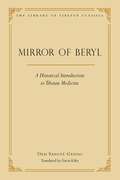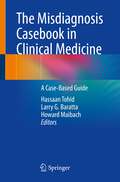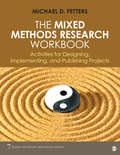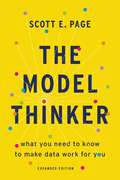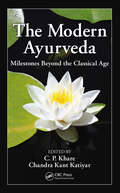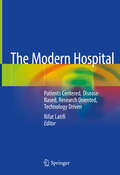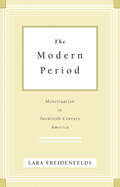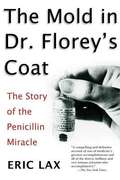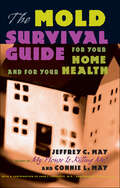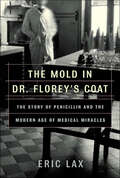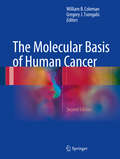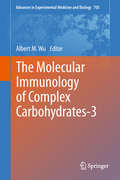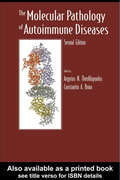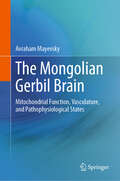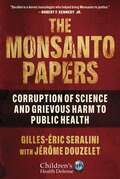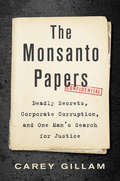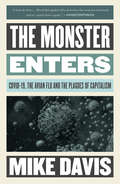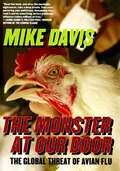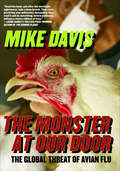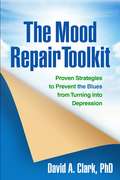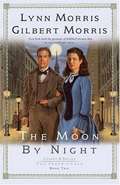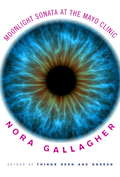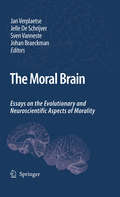- Table View
- List View
The Mirror of Beryl: A Historical Introduction to Tibetan Medicine (Library of Tibetan Classics #28)
by Gavin Kilty Sangye Desi GyatsoComposed while its author was the ruler of Tibet, Mirror of Beryl is a detailed account of the origins and history of medicine in Tibet through the end of the seventeenth century. Its author, Desi Sangye Gyatso (1653 - 1705), was the heart disciple and political successor of the Great Fifth Dalai Lama and the author of several highly regarded works on Tibetan medicine, including his Blue Beryl, a commentary on the foundational text of Tibetan medicine, The Four Tantras. In the present historical introduction, Sangye Gyatso traces the sources of influence on Tibetan medicine to classical India, China, Central Asia, and beyond, providing life stories, extensive references to earlier Tibetan works on medicine, and fascinating details about the Tibetan approach to healing. He also provides a commentary on the pratimoksha, bodhisattva, and tantric Buddhist vows. Desi Sangye Gyatso's Mirror of Beryl remains today an essential resource for students of medical science in Tibet.
The Misdiagnosis Casebook in Clinical Medicine: A Case-Based Guide
by Howard Maibach Hassaan Tohid Larry G. BarattaOne third of misdiagnosed medical cases result in serious injury or death. Moreover, 40,000-80,000 deaths occur each year in the United States alone because of misdiagnosis. This is a major clinical crisis that medical schools and hospitals have failed to adequately address. There is currently no book available that provides general clinicians with the knowledge to prevent such lethal errors in a variety of disciplines.Composed of clinical cases, the book represents seventy chapters fashioned into sixteen modules and are organized by systems, such as allergy and immunology, cardiology, neurology and rheumatology, just to name a few. Each chapter is organized with a general introduction to the topic followed by the name of the specific disease. Next comes the actual clinical case presentation followed by the differential diagnosis. It then explains what was misdiagnosed in the specific case and why. A general discussion and plan of action is then described followed by a conclusion. Uniquely incorporated in the book is a chapter dedicated to the legal perspectives of misdiagnosis followed by an editor’s perspective. The Misdiagnosis Casebook in Clinical Medicine is a valuable and much-needed resource for clinicians as well as practitioners in all areas of medicine.
The Mixed Methods Research Workbook: Activities for Designing, Implementing, and Publishing Projects (Mixed Methods Research Series #7)
by Michael D. FettersWritten by Michael D. Fetters, one of the leading scholars in the field and co-editor of the Journal of Mixed Methods Research, The Mixed Methods Research Workbook: Activities for Designing, Implementing, and Publishing Projects is the perfect tool for doctoral students and researchers who want support throughout their research project, as well as a practical way to apply the knowledge they’ve learned. With The Mixed Methods Research Workbook, you’ll be ready to tackle your mixed methods research project with confidence. Each chapter follows a familiar framework, starting with learning objectives for each piece of the mixed methods process. Readers have ample space in this text to write notes, fill out activities, and begin their process of actively designing and writing up a mixed methods study. This easy-to follow process gives readers an immediate structure to their projects. Exemplar boxes provide a starting framework, with the text encouraging deeper reflection on mixed methods challenges and opportunities. Stories from the field illuminate struggles and suggestions with the benefit of hindsight. Checklists at the end of each chapter help readers stay organized and key resources provide up-to-date lists of material for further study. From start to finish, readers can follow along with this text as they work on their projects. The text begins by assisting readers in identifying topics and conducting literature reviews in the context of mixed methods, zeroing in to address mixed-methods-specific challenges like integration, leveraging advantages of both qualitative and quantitative methods, and incorporating theory and personal backgrounds. Identifying data sources helps readers organize their data collection. Two chapters on research designs structure the data collection process with procedural diagrams. A unique chapter on mixed methods sampling offers application through basic and advanced designs. The book illustrates integrating and implementing mixed methods designs with practical advice for each of stage of the process. Ethics in a mixed methods context readies readers for the research protocol stage. Several chapters fully explicate the data analysis process, including developing a joint display, a state-of-the-art procedure for analysis and presentation of findings. Closing out the process, the text tackles quality and evaluation in mixed methods studies, preparing your study for publication, and writing up your article.
The Mixed Methods Research Workbook: Activities for Designing, Implementing, and Publishing Projects (Mixed Methods Research Series #7)
by Michael D. FettersWritten by Michael D. Fetters, one of the leading scholars in the field and co-editor of the Journal of Mixed Methods Research, The Mixed Methods Research Workbook: Activities for Designing, Implementing, and Publishing Projects is the perfect tool for doctoral students and researchers who want support throughout their research project, as well as a practical way to apply the knowledge they’ve learned. With The Mixed Methods Research Workbook, you’ll be ready to tackle your mixed methods research project with confidence. Each chapter follows a familiar framework, starting with learning objectives for each piece of the mixed methods process. Readers have ample space in this text to write notes, fill out activities, and begin their process of actively designing and writing up a mixed methods study. This easy-to follow process gives readers an immediate structure to their projects. Exemplar boxes provide a starting framework, with the text encouraging deeper reflection on mixed methods challenges and opportunities. Stories from the field illuminate struggles and suggestions with the benefit of hindsight. Checklists at the end of each chapter help readers stay organized and key resources provide up-to-date lists of material for further study. From start to finish, readers can follow along with this text as they work on their projects. The text begins by assisting readers in identifying topics and conducting literature reviews in the context of mixed methods, zeroing in to address mixed-methods-specific challenges like integration, leveraging advantages of both qualitative and quantitative methods, and incorporating theory and personal backgrounds. Identifying data sources helps readers organize their data collection. Two chapters on research designs structure the data collection process with procedural diagrams. A unique chapter on mixed methods sampling offers application through basic and advanced designs. The book illustrates integrating and implementing mixed methods designs with practical advice for each of stage of the process. Ethics in a mixed methods context readies readers for the research protocol stage. Several chapters fully explicate the data analysis process, including developing a joint display, a state-of-the-art procedure for analysis and presentation of findings. Closing out the process, the text tackles quality and evaluation in mixed methods studies, preparing your study for publication, and writing up your article.
The Model Thinker: What You Need to Know to Make Data Work for You
by Scott E. PageHow anyone can become a data ninja From the stock market to genomics laboratories, census figures to marketing email blasts, we are awash with data. But as anyone who has ever opened up a spreadsheet packed with seemingly infinite lines of data knows, numbers aren't enough: we need to know how to make those numbers talk. In The Model Thinker, social scientist Scott E. Page shows us the mathematical, statistical, and computational models--from linear regression to random walks and far beyond--that can turn anyone into a genius. At the core of the book is Page's "many-model paradigm," which shows the reader how to apply multiple models to organize the data, leading to wiser choices, more accurate predictions, and more robust designs. The Model Thinker provides a toolkit for business people, students, scientists, pollsters, and bloggers to make them better, clearer thinkers, able to leverage data and information to their advantage.
The Modern Ayurveda: Milestones Beyond the Classical Age
by C. P. Khare Chandra Kant KatiyarThe Indian population has used Ayurvedic herbs for centuries, but now modern scientific work has led to recognition and acceptance at a global level. The major cause of the increased popularity of Ayurvedic medicine stems from recent scientific validation and its potential in lifestyle management. This growth in research in India and worldwide has
The Modern Hospital: Patients Centered, Disease Based, Research Oriented, Technology Driven
by Rifat LatifiThe rapidly growing developments in medicine and science in the last few decades has evoked a greater need for modern institutions, with modern medicine, advanced technologies, and cutting edge research. Today, the modern hospital is a highly competitive, multibillion dollar industry that plays a large role in our healthcare systems. Far different from older institutions, modern hospitals juggle the dynamics of running a business that proves financially fruitful and sustainable, with maintaining and staying ahead of medical developments and offering the best possible patient care. This comprehensive book explores all aspects of the inner workings of a modern hospital, from research and technology driven treatment and patient centered care, to the organizational, functional, architectural, and ergonomic aspects of the business. The text is organized into three parts. The first part covers a number of important aspects of the modern hospital including hospital transformation over the centuries, the new medical world order, overall concept, academic mission and economics of new healthcare. Additionally, experts in the field address issues such as modern design functionally and creating an environment that is ergonomically friendly, technologically advanced, and easy to navigate for both worker and patient. Other topics covered include, the role of genomics and nano-technologies, controversies that come with introducing new technologies, the world-wide pharmaceutical industry, electronic medical health records, informatics, and quality of patient care. Part II addresses nine specific elements of modernization of the hospital that deal with high acuity, life and death situations, and complex medical and surgical diseases. These chapters cover the organization of new emergency departments, trauma room, hybrid operating rooms, intensive care units, radiology, pharmaceutical and nutritional support, and most essential, patient and public relation services. These nine elements reflect the most important and most visible indicators of modernization and transformation of the hospital. Part III examines and highlights the team approach as a crucial component of the transformation, as well as specific perspectives on the modern hospital from nurses, physicians, surgeons and administrators. Finally, a chapter dedicated to patient perspective is also presented. The Modern Hospital provides an all-inclusive review of the hospital industry. It will serve as a valuable resource for administrators, clinicians, surgeons, nurses, and researchers. All chapters will be written by practicing experts in their fields and include the most up-to-date scientific and clinical information.
The Modern Period: Menstruation in Twentieth-Century America
by Lara FreidenfeldsWinner, 2010 Emily Toth Award for Best Book in Women’s Studies, Popular Culture Association/American Culture AssociationThe Modern Period examines how and why Americans adopted radically new methods of managing and thinking about menstruation during the twentieth century. In the early twentieth century women typically used homemade cloth "diapers" to absorb menstrual blood, avoided chills during their periods to protect their health, and counted themselves lucky if they knew something about menstruation before menarche. New expectations at school, at play, and in the workplace, however, made these menstrual traditions problematic, and middle-class women quickly sought new information and products that would make their monthly periods less disruptive to everyday life.Lara Freidenfelds traces this cultural shift, showing how Americans reframed their thinking about menstruation. She explains how women and men collaborated with sex educators, menstrual product manufacturers, advertisers, physical education teachers, and doctors to create a modern understanding of menstruation. Excerpts from seventy-five interviews—accounts by turns funny and moving—help readers to identify with the experiences of the ordinary people who engineered these changes. The Modern Period ties historical changes in menstrual practices to a much broader argument about American popular modernity in the twentieth century. Freidenfelds explores what it meant to be modern and middle class and how those ideals were reflected in the menstrual practices and beliefs of the time. This accessible study sheds new light on the history of popular modernity, the rise of the middle class, and the relationship of these phenomena to how Americans have cared for and managed their bodies.
The Mold In Dr. Florey's Coat: The Story Of The Penicillin Miracle
by Eric LaxAlexander Fleming's discovery of penicillin in his London laboratory in 1928 and its eventual development as the first antibiotic by a team at Oxford University headed by Howard Florey and Ernst Chain in 1942 led to the introduction of the most important family of drugs of the twentieth century. <P><P> Yet credit for penicillin is largely misplaced. Neither Fleming nor Florey and his associates ever made real money from their achievements; instead it was the American labs that won patents on penicillin's manufacture and drew royalties from its sale. Why this happened, why it took fourteen years to develop penicillin, and how it was finally done is a fascinating story of quirky individuals, missed opportunities, medical prejudice, brilliant science, shoestring research, wartime pressures, misplaced modesty, conflicts between mentors and their protegees, and the passage of medicine from one era to the next. <P> Includes Bibliographic references and extensive notes. At the end of the book, after the index are pages of photo captions with some image descriptions.
The Mold Survival Guide: For Your Home and for Your Health
by Jeffrey C. May Connie L. MayThe image was shocking: a couple wearing protective suits and masks in their own home! The accompanying USA Weekend story documented the mold-related headaches, fatigue, and respiratory problems that forced Melinda Ballard and Ron Allison to abandon their dream house, leaving all their possessions behind. Another family was so terrified that they had their mold-filled house torn down.Mold growth threatens property managers and builders, as well as home owners and renters. Legal settlements in some mold cases have reached the millions, and home insurance rates are skyrocketing. Some people argue that mold concerns are exaggerated; others are convinced that mold growth is destroying their health.In The Mold Survival Guide, a prominent indoor air quality professional teams up with a writing specialist to describe mold, to explain where and why it flourishes in homes, and to offer advice on how to eradicate mold while minimizing health risks. The book includes a chapter by two physicians who explain how exposure to mold can affect health.With clear scientific explanations and expert advice, The Mold Survival Guide is a valuable resource for anyone worried about a common household problem that can have serious consequences.
The Mold in Dr. Florey's Coat: The Story of Penicillin and the Modern Age of Medical Miracles
by Eric LaxThe dramatic, untold story of the discovery of the first wonder drug, the men who led the way, and how it changed the modern worldIn his wonderfully engaging book, acclaimed author Eric Lax tells the real story behind the discovery and why it took so long to develop the drug. He reveals the reasons why credit for penicillin was misplaced, and why this astonishing achievement garnered a Nobel Prize but no financial rewards for the doctor that discovered it and the team that developed it.Alexander Fleming's discovery of penicillin in his London laboratory in 1928 ushered in a new age in medicine. But it took a team of Oxford scientists headed by Howard Florey and Ernst Chain four more years to develop it as the first antibiotic, and the most important family of drugs in the twentieth century. At once the world was transformed -- major bacterial scourges such as blood poisoning and pneumonia, scarlet fever and diphtheria, gonorrhea and syphilis were defeated. Penicillin helped to foster not only a medical revolution but a sexual one as well.The Mold in Dr. Florey's Coat is the compelling story of the passage of medicine from one era to the next and of the eccentric individuals whose participation in this extraordinary accomplishment has, until now, remained largely unknown. "Admirable, superbly researched . . . perhaps the most exciting tale of science since the apple dropped on Newton's head." -- Simon Winchester, The New York Times
The Molecular Basis of Human Cancer
by William B. Coleman Gregory J. TsongalisThis book covers the concepts of molecular medicine and personalized medicine. Subsequent chapters cover the topics of genomics, transcriptomics, epigenomics, and proteomics, as the tools of molecular pathology and foundations of molecular medicine. These chapters are followed by a series of chapters that provide overviews of molecular medicine as applied broadly to neoplastic, genetic, and infectious diseases, as well as a chapter on molecular diagnostics. The volume concludes with a chapter that delves into the promise of molecular medicine in the personalized treatment of patients with complex diseases, along with a discussion of the challenges and obstacles to personalized patient care. The Molecular Basis of Human Cancer, Second Edition, is a valuable resource for oncologists, researchers, and all medical professionals who work with cancer.
The Molecular Immunology of Complex Carbohydrates-3
by Albert M. WuBased on the third symposium on "Molecular Immunology of Complex Carbohydrates," this text covers the latest in glycotopes, structures and functions of complex carbohydrates, recognition factors of lectins, biomolecular interactions and other glycosciences. This volume highlights the informative events of the Symposium on Molecular Immunology of Complex Carbohydrates III, held at the Institute of Biological Chemistry, Academia Sinica, on July 15-20, 2007, in Taipei, Taiwan.
The Molecular Pathology of Autoimmune Diseases
by Argyrios N.Theofilopoulos and Constantin A.BonaRemarkable advances have been made in the pathogenesis of autoimmunity, such as with bone marrow transplantation, which is becoming a powerful strategy in treating certain life-threatening diseases. The Molecular Pathology of Autoimmune Diseases is a concise and centralized resource for information on the topic, with a special focus on the molecula
The Mongolian Gerbil Brain: Mitochondrial Function, Vasculature, and Pathophysiological States
by Avraham MayevskyThe Mongolian gerbil brain lies in the anatomy of the blood vessels supplying blood to the brain. In all mammals, there is a special mechanism that compensates for the decreased blood flow to the brain in the case of development of stroke. This mechanism is missing in the gerbil and therefore makes the Mongolian gerbil a unique model for stroke. Dr. Mayevsky adopted the gerbil as a model for stroke and his laboratory uniquely studied the mitochondria in the gerbil brain under various pathophysiological conditions.This book describes the history of the Mongolian gerbil in research, the brain energy metabolism and mitochondrial function and brain real-time monitoring systems used in gerbils, as well as the brain vasculature of the Mongolian gerbil. Further, the book includes chapters on brain multisite recording under brain perturbations, multiparametric responses to brain activation, and the effect of neuroprotectants on the gerbil brain. This is an ideal book for research teams researching stroke and epilepsy.
The Monsanto Papers: Corruption of Science and Grievous Harm to Public Health (Children’s Health Defense)
by Gilles-Éric Seralini Jérôme DouzeletA David and Goliath battle for truth A specialist in GM foods and pesticides, the biologist Gilles-Éric Seralini has studied their toxicity and effects on people's health for many years. In September 2012, for the first time in a major scientific journal (Food and Chemical Toxicology), he published a study showing the effect on the liver and kidneys of two of Monsanto's flagship products: Roundup weedkiller and the GM foods created to absorb it. Images from the study of tumor-ridden rats fed with GM foods and Roundup went viral. The study was a PR disaster for Monsanto. The multinational soon bounced back and did everything in its power to cover up the study—leaning on the publishers to retract the findings. Monsanto began a series of smear campaigns to discredit Seralini and fellow researchers and intimidate their supporters, while pumping out their own collection of fake research findings and testimonies. These practices were met with huge suspicion, but there was no concrete evidence until, in 2017, Monsanto was ordered to publish tens of thousands of confidential documents in a class-action lawsuit presented by thousands of individuals afflicted with serious illnesses from their use of Roundup. The "Monsanto Papers" that were produced subsequently proved the company&’s cynical attempts at a cover-up as well as its fraudulent practices. Gilles-Éric Seralini and Jérôme Douzelet delved into the documents and discovered how, in the pursuit of its own short term economic interests, Monsanto used sophisticated methods of deceit to bypass legislation devised to protect millions of people. Seralini and Douzelet discovered how Monsanto managed to provide phony assessments to conceal the poisons its products contain, thus deceiving the public authorities and the scientific and medical communities.
The Monsanto Papers: Deadly Secrets, Corporate Corruption, and One Man's Search for Justice
by Carey GillamLee Johnson was a man with simple dreams. All he wanted was a steady job and a nice home for his wife and children, something better than the hard life he knew growing up. He never imagined that he would become the face of a David-and-Goliath showdown against one of the world's most powerful corporate giants. But a workplace accident left Lee doused in a toxic chemical and facing a deadly cancer that turned his life upside down. In 2018, the world watched as Lee was thrust to the forefront of one the most dramatic legal battles in recent history. The Monsanto Papers is the inside story of Lee Johnson's landmark lawsuit against Monsanto. For Lee, the case was a race against the clock, with doctors predicting he wouldn't survive long enough to take the witness stand. For the eclectic band of young, ambitious lawyers representing him, it was a matter of professional pride and personal risk, with millions of dollars and hard-earned reputations on the line. For the public at large, the lawsuit presented a question of corporate accountability. With enough money and influence, could a company endanger its customers, hide evidence, manipulate regulators, and get away with it all—for decades? Readers will be astounded by the depth of corruption uncovered, captivated by the shocking twists, and moved by Lee's quiet determination to see justice served. With gripping narrative force that reads like fiction, The Monsanto Papers takes readers behind the scenes of a grueling legal battle, pulling back the curtain on the frailties of the American court system and the lengths to which lawyers will go to fight corporate wrongdoing.
The Monster Enters: COVID-19, Avian Flu, and the Plagues of Capitalism
by Mike DavisA new edition of a classic book on viral catastrophes--the Spanish flu, the Avian flu, and now, Covid-19In his book, The Monster at Our Door, the renowned activist and author Mike Davis warned of a coming global threat of viral catastrophes. Now in this expanded edition of that 2005 book, Davis explains how the problems he warned of remain, and he sets the COVID-19 pandemic in the context of previous disastrous outbreaks, notably the 1918 influenza disaster that killed at least forty million people in three months and the Avian flu of a decade and a half ago.In language both accessible and authoritative, The Monster Enters surveys the scientific and political roots of today&’s viral apocalypse. In doing so it exposes the key roles of agribusiness and the fast-food industries, abetted by corrupt governments and a capitalist global system careening out of control, in creating the ecological pre-conditions for a plague that has brought much of human existence to a juddering halt.
The Monster at Our Door: The Global Threat of Avian Flu
by Mike DavisIn this urgent and extraordinarily frightening book, Mike Davis reconstructs the scientific and political history of a viral apocalypse in the making, exposing the central roles of agribusiness and the fast-food industries, abetted by corrupt governments, in creating the ecological conditions for the emergence of this new plague. He also details the scandalous failure of the Bush administration, obsessed with hypothetical "bio-terrorism," to safeguard Americans from the greatest biological threat since HIV/AIDS.
The Monster at Our Door: The Global Threat of Avian Flu
by Mike DavisThe MacArthur Fellow and author of Dead Cities presents a terrifying forecast of a new global threat—and &“its argument is irrefutable&” (The Independent). Hailed by The Nation as a &“master of disaster prose,&” author and activist Mike Davis addresses the imminent catastrophe of Avian influenza. In 1918, a pandemic strain of influenza killed at least forty million people in three months. Now, leading researchers believe, another global outbreak is all but inevitable. A virus of astonishing lethality, known as H5N1, has become entrenched in the poultry and wild bird populations of East Asia. It kills two out of every three people it infects. The World Health Organization warns that it is on the verge of mutating into a super-contagious pandemic form that could visit several billion homes within two years. In this urgent and alarming book, Mike Davis reconstructs the scientific and political history of a viral apocalypse in the making, exposing the central roles of agribusiness and the fast-food industries, abetted by corrupt governments, in creating the ecological conditions for the emergence of this new plague.
The Mood Repair Toolkit
by David A. ClarkIf you have trouble bouncing back from low moods or just feel stuck in the doldrums much of the time, renowned cognitive behavior therapist David A. Clark has a clear message: there are simple yet powerful steps you can take to feel better. This encouraging book presents 80 strategies you can use to reduce sadness, promote positive feelings of contentment and joy, and decrease your risk for full-blown depression. Vivid stories and concrete examples help you learn specific methods for: *Nipping negativity in the bud. *Making unhappiness less overwhelming. *Defusing self-criticism and rumination. *Boosting your energy and motivation for change. *Feeling more confident and hopeful every day. Using the practical tools in the book--forms, worksheets, and self-assessment quizzes--makes it easy to create and stick to a mood repair action plan. You can download and print additional copies of these tools as needed. The strategies that Dr. Clark provides are grounded in cutting-edge neuroscience and psychology research--and they work. Discover proven ways to start living a more satisfying and productive life.
The Mood Repair Toolkit
by David A. ClarkIf you have trouble bouncing back from low moods or just feel stuck in the doldrums much of the time, renowned cognitive behavior therapist David A. Clark has a clear message: there are simple yet powerful steps you can take to feel better. This encouraging book presents 80 strategies you can use to reduce sadness, promote positive feelings of contentment and joy, and decrease your risk for full-blown depression. Vivid stories and concrete examples help you learn specific methods for: *Nipping negativity in the bud. *Making unhappiness less overwhelming. *Defusing self-criticism and rumination. *Boosting your energy and motivation for change. *Feeling more confident and hopeful every day. Using the practical tools in the book--forms, worksheets, and self-assessment quizzes--makes it easy to create and stick to a mood repair action plan. You can download and print additional copies of these tools as needed. The strategies that Dr. Clark provides are grounded in cutting-edge neuroscience and psychology research--and they work. Discover proven ways to start living a more satisfying and productive life.
The Moon by Night (Cheney And Shiloh: The Inheritance Ser. #2)
by Gilbert Morris Lynn MorrisCheney and Shiloh Irons-Winslow return to New York from their honeymoon in the West Indies eager to resume their careers. Cheney is thrilled with the newly opened St. Luke the Physician Hospital, which she helped design and renovate. To her dismay, however, it soon appears that several surgeries have been compromised and patients are contracting new illnesses rather than getting well. As evidence of foul play mounts, Cheney works feverishly to expose the true villain and reveal the desperate secrets that fuel these crimes. Shiloh is running the Winslow Brothers Shipping Company, but it soon is so well organized that boredom haunts him. Cheney is so caught up in medical emergencies, day and night, that he must visit her at the hospital. Though Shiloh’s nursing experience could alleviate some of the stress, Cheney believes he doesn’t want to return to medicine and determines not to ask for his help. Will her resolve drive a wedge between them? In the Midst of Growing Adversity, Their Love is Put to the Test
The Moonlight Sonata at the Mayo Clinic
by Nora GallagherThis taut yet lyrical memoir tells of the author's experience with a baffling illness poised to take her sight, and gives a deeply felt meditation on vulnerability and on what it means to lose the faith you had and find something better. One day at the end of 2009, during a routine eye exam that Nora Gallagher nearly skipped, her doctor said, "Darn." Her right optic nerve was inflamed, the cause unknown, a condition that if left untreated would cause her to lose her sight. And so began her departure from ordinary life and her travels in what she calls Oz, the land of the sick. It looks like the world most of us inhabit, she tells us, except that "the furniture is slightly rearranged": her friends can't help her, her trusted doctors don't know what's wrong, and what faith she has left just won't cover it. After a year of searching for a diagnosis and treatment, she arrives at the Mayo Clinic and finds a whole town built around Oz.In the course of her journey, Gallagher encounters inhuman doctors, the modern medical system--in which knowledge takes fifteen years to trickle down--and the strange world that is the famous Mayo Clinic, complete with its grand piano. With unerring candor, and no sentimentality whatsoever, Gallagher describes the unexpected twists and turns of the path she took through a medical mystery and an unfathomably changing life. In doing so, she gives us a singular, luminous map of vulnerability and dark landscapes. "It's the nature of things to be vulnerable," Gallagher says. "The disorder is imagining we are not."
The Moral Brain
by Johan Braeckman Jelle De Schrijver Jan Verplaetse Sven VannesteScientists no longer accept the existence of a distinct moral organ as phrenologists once did. A generation of young neurologists is using advanced technological medical equipment to unravel specific brain processes enabling moral cognition. In addition, evolutionary psychologists have formulated hypotheses about the origins and nature of our moral architecture. Little by little, the concept of a 'moral brain' is reinstated. As the crossover between disciplines focusing on moral cognition was rather limited up to now, this book aims at filling the gap. Which evolutionary biological hypotheses provide a useful framework for starting new neurological research? How can brain imaging be used to corroborate hypotheses concerning the evolutionary background of our species? In this reader, a broad range of prominent scientists and philosophers shed their expert view on the current accomplishments and future challenges in the field of moral cognition and assess how cooperation between neurology and evolutionary psychology can boost research into the field of the moral brain.
